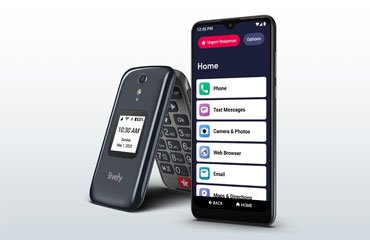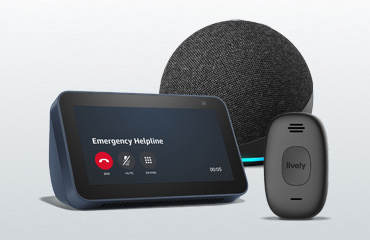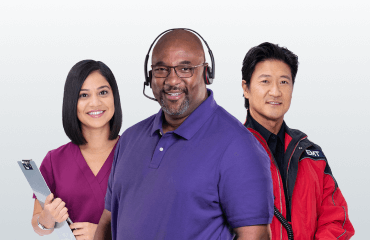When we live with other people, we watch out for each other as if by second nature--sometimes so subtly we may not even notice we’re doing so.
...these teams are using the noninvasive technologies to help ensure everything is safe.
Has Dad eaten three square meals today? Does Mom’s sleep seem a bit more fractured? Is somebody getting up in the middle of the night?
Now, as the aging and retiring generation swells, many are choosing to age in place. And without attentive caregivers living in the home, it is not surprising that some older people living alone may find it increasingly difficult to keep track of complex daily tasks and activities that keep us healthy.
From sleep and nutrition to hydration and daily exercise or remembering to take the right medications at the right times, managing an independent lifestyle (and sometimes chronic health conditions) can be complicated.
Many older adults who live by themselves can benefit from the unobtrusive monitoring of a remote care team. Without actually looking or listening, through tiny bits of data, these teams are using the noninvasive technologies to help ensure everything is safe and all is well at home--from a distance.
What is passive remote monitoring? How does it work?
Passive remote monitoring is an innovative way of using internet-connected sensors that combine remote smart home technology, predictive analytics, health data, live health care experts, and artificial intelligence to help improve senior health and safety.
Many active, healthy seniors are perfectly capable of managing their own medications, meals, sleep, activity, mobility, balance, and daily hydration. And at the same time, some families and medical care teams may decide (after a family consultation that includes Mom!) that they would appreciate the extra feeling of security that comes from knowing someone is keeping an eye on everything at home, even when their loved ones are sleeping or going about their daily routine.
More people today of every age are aware today of the Internet of Things—a quick-and-easy shorthand term for any kind of device connected to the Internet.
Passive remote monitoring takes advantage of the Internet of Things to help keep seniors safe and independent—as unobtrusively and seamlessly as possible. Such systems can be as simple or complex as needs dictate, using discreet sensors placed around the home to keep track of motion, temperature, light, and other input—even frequency patterns of toilet flushes.
How does passive remote monitoring work?
Every passive remote monitoring system works a bit differently, but most systems require sensor setup and calibration, as well as establishing parameters around ranges of “normal activity.” Most people don’t, for example, get out of bed promptly at 8:00 a.m. every day. Normal variation in activity levels throughout the day should not raise alarms. So calibration during setup helps to prevent false positives or red flags when nothing is actually wrong.
As sensors and devices collect data throughout the day, they send the information to a central processing hub through the Internet. That data is then compared to baseline data. Anything that falls too far outside the “normal” zone is flagged as a potential cause for concern and escalated in the care management system.
Some systems, like video doorbells, may send automated alerts to a designated caregiver via email or mobile phone when activity in the monitored zone falls outside of the baseline. Other systems may alert a live case manager who works for an insurance company or a healthcare organization, who is then assigned to reach out via a phone call to make sure everything is OK. Is Mom taking her medications? (The medicine cabinet didn’t open.) Did Dad eat today? (The refrigerator has remained closed all day.)
Passive remote monitoring systems are frequently covered by insurance and are personalized, specifically targeting individual activity anomalies early and help reduce or even eliminate health crises and trips to the emergency room. These systems include:
Smart refrigerators
that can keep track of food freshness and how quickly it is consumed between restocks.
Bathroom sensors
to detect the number of toilet flushes per day, used to help identify potential infection or dehydration issues before they become serious.
Sensors placed under a mattress
to help caretakers who live at a distance understand how frequently and at what hours Mom is up and around at night—as well as when she’s safely back in bed—all without cameras or microphones, by design, to protect privacy.
Motion sensors around the home
that can be compared on a day-to-day, week-to-week, and month-to-month basis to flag early changes.
Connected home voice assistants
that offer Mom and her favorite caretaker the convenience of being able to talk to each other without devices or hands. Using plain language commands like “Call my son,” or “Drop in on my niece,” they can ensure more peace-of-mind by establishing several alternative lines of backup communication.

Once a passive remote monitoring system is installed and configured, the monitored home’s resident typically does not need to interact with or maintain the sensors (although as with all technology, it’s generally helpful to have someone tech-savvy available or on-call for help with troubleshooting).
How is passive remote monitoring different from traditional monitoring technology?
In the past, in-home senior monitoring was severely limited, both in scope and in use, and it required active participation by the home’s resident(s)—usually in the form of wearing pendants or bracelets that could detect a fall or make an emergency call for help using an emergency button through a landline-wired or cellular base station.
Passive remote monitoring, by contrast, removes the necessity for the person in the home to be a 24/7/365 intentional participant in his or her own health care, medication, safety, motion, exercise, and activity monitoring.
By opting into an insurance-covered service that uses predictive analytics to help follow and track their risks, Baby Boomers are doing what they’ve always done: Joining the leading edge of a revolution, changing the way things have always been done.
Is passive remote monitoring secure/safe to use?
A common concern about remote monitoring technology is data security and privacy. Because data related to our health is one of our most talked-about modern privacy issues, the question is legitimate.
Reputable third-party data technology companies adhere to federal and state privacy laws that protect access to and disclosure of records about individuals retrieved by personal identifiers. These include The Health Insurance Portability and Accountability Act of 1996, known as HIPAA, which contains privacy, security and breach notification requirements concerned with personal health-related data.
As we get older, the likelihood of needing help increases.
Companies should have notifications of Privacy Policies available for anyone to review and understand. If a healthcare company offers passive remote monitoring as a part of their Medicare or Medicaid benefit options, an extensive review of third-party partners is performed, requiring a data protection policy be in place, and member materials are reviewed by the Centers for Medicare & Medicaid Services (CMS) before being sent to members.
It is important to understand your rights and choices when considering passive remote monitoring technologies so that you can have peace of mind about your personal information.
Reasons to consider passive remote monitoring technology
Specific people can benefit more from passive remote monitoring than others. In consultation with a medical care team and family or caregivers, independent seniors may enjoy benefits from passive remote monitoring technology if they:
Live with any form of chronic illness
Have limited mobility
Are limited in their geographic or physical access to health care facilities
Are frail or otherwise find it difficult to travel to health care appointments
Learn more about passive remote monitoring
If you are interested in learning more about passive remote monitoring technology for yourself or a loved one whose care you help to coordinate, resources are available. You can get in touch with the person’s insurance company to begin with; find out whether they offer coverage for these systems. In 2017, Medicaid recognized the value of preventing medical emergencies through passive remove monitoring and began to help defray the cost of these systems. Physicians, social workers, and manufacturers can also offer more in-depth information about the different types, configurations, and options available.
Here’s more from Lively.
swipe for more
scroll or use your arrow keys for more
scroll for more
use your arrow keys for more



